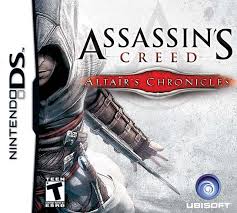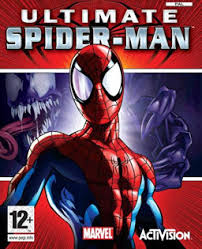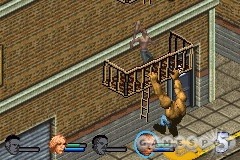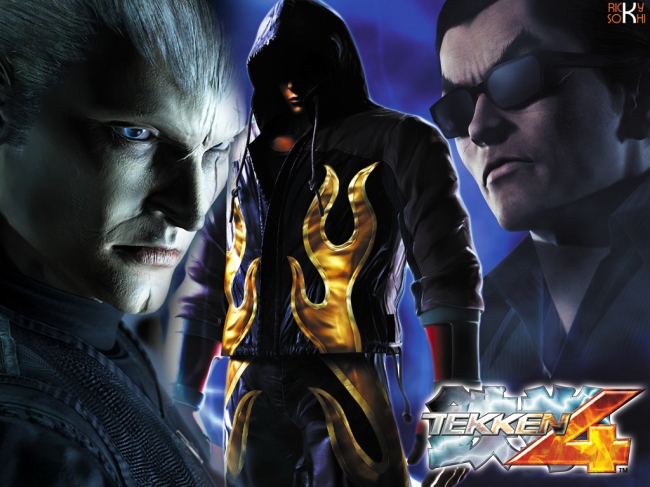Category Archives: Fighting
Fighting
Iron Man Pc Game Free Download
Ultimate Spider Man Free Download Pc
Tekken Tag Pc Game Free Download
The Tekken series has always stood as a set of console games that went above and beyond their arcade counterparts. From additional characters to completely new modes, the series has always tried to add something that the arcade games lacked. Tekken Tag Tournament, at first glance, is the most dramatic upgrade over an arcade Tekken game to date. The graphics have been given a huge boost, similar to the upgrade that Namco’s weapon-based fighter, Soul Calibur, received when it hit the Dreamcast last year. Plus, new modes have been added. But does the series capture the same magical feeling that made the previous Tekken games such smash hits? Most definitely.
Tekken Tag Tournament serves as an upgrade to Tekken 3, adding a few new moves along the way. Fighters that had appeared in Tekken 2 but were missing from Tekken 3 have been brought back as well, and most of them have lots of new moves to help balance them with the more powerful Tekken 3 fighters. Finally, the game is now fought in the same tag-team style as Capcom’s versus series of fighters, so you can switch between two different characters at any time. Much like Street Fighter EX3 and Dead or Alive 2, you can have up to four players, with each player controlling a different fighter in the tag battle. However, unlike most other tag-battle fighters, Tekken Tag rounds end after only one of the two fighters have been defeated, rather than letting the battle continue as a one-on-two affair. An option that let you configure this would have been nice. Aside from the standard tag-battle arcade mode, there is also a one-on-one mode, that makes Tekken Tag Tournament more like the previous Tekken games, as well as the standard team battle (though it is now a tag-team battle), time attack, and survival modes. Unlockable modes include a theater mode, where you can watch all of the game’s endings; a gallery mode, which lets you pause the game at any time and snap a screenshot of the action that is saved to your memory card for later viewing; and Tekken bowl mode, a bowling minigame that lets you hit the lanes and toss glimmer globes at Heihachi-headed bowling pins. Each character has a different bowling style that affects speed and control. The character endings, with the exception of the game’s final boss, are rendered using the game engine. This presumably saved time during the game’s development. As a result, they’re short, mostly meaningless, and decidedly less than impressive. By comparison, the prerendered intro and the final boss’ prerendered ending are simply incredible pieces of footage. In Japan, the TV commercial for the game is simply an abridged version of the game’s new intro movie. Very striking stuff.
Graphically, the game has taken a very large leap, and the arcade version of the game looks downright ugly by comparison. The characters are very, very smooth, and the backgrounds are amazing and filled with lots of movement, from helicopters to crowds of spectators. Some stages are well lit, showing off some really excellent lens-flare techniques. There are also some nice little touches, such as grass being crushed down by falling fighters then slowly springing up afterward. However, the game suffers from one particular problem that has in fact been seen throughout the series, but with the power of the PlayStation 2 behind it, you’d expect it to be a thing of the past. The problem is the same one that showed up in Street Fighter EX3. While the backdrops of the fights and the ground on which you fight look great separately, they don’t mesh very well. The result is two different types of scrolling, making it look as if the battle is occurring on a small, circular spinning platform surrounded by a nearly stationary background. It’s easy to miss while you’re actually playing, but it sticks out like a sore thumb on watching the game closely. However, the game has been cleaned up a lot when compared to the Japanese release. The characters are smooth, the backgrounds and floors appear more refective and vibrant, and the game just has a significantly more polished look to it. The game uses much of the same animation and motion-capture data from Tekken 3. Sure, the characters look pretty incredible, but with the identical animation quality, even as good as that animation was, the game looks and feels a little on the stale side. The soundtrack is full of techno and vocoder robot voices that will either endear you to the soundtrack or drive you up the wall.
How much you enjoy the game will directly relate to one factor: If you played so much Tekken 2 and 3 that you couldn’t possibly play another match, Tekken Tag doesn’t offer enough new features to draw you back in. But if you’ve stayed away from the Tekken series for a long time, Tekken Tag is a very warm homecoming, delivering the same solid gameplay that Tekken fans crave in large doses. Still, you won’t be able to stop yourself from wondering what Namco could have done with the game if it had been designed on the PS2 (or comparable arcade hardware) from the start. Guess we’ll all have to wait for Tekken 4 to find that out.
Direct Download Link
Mafia 2 Pc Game Very Highly Compressed 4 MB
Fantastic 4 Game Free Download
Sadly, the days of the classic beat-’em-up are long gone. Every once in a while, however, a developer dares to take a stab at the genre made popular by games like Double Dragon, Final Fight, and Streets of Rage. Take Fantastic 4 for the Game Boy Advance, for example. While it may be just the latest in a never-ending litany of games intended to take advantage of the consumerism spawned by the release of a blockbuster movie, it also happens to be a solid entry in the “beat up anything that moves” genre.
The game’s seven worlds (40 levels in all) are loosely patterned after situations from the film. Early on, the narrative focuses on the individual team members’ struggles to come to grips with their newfound powers, which were given to them when a freak cosmic storm engulfed the space station where they were conducting scientific research. Ben Grimm becomes the rock monster known as “The Thing.” Reed Richards develops the ability to stretch his body like a rubber band and takes the nickname “Mr. Fantastic.” Sue Storm ends up with telekinetic powers and the ability to turn invisible, thus earning the moniker “Invisible Girl.” Last but certainly not least, Sue’s brother, Johnny Storm, becomes the living fireball known as the “Human Torch.” Once all the introductions are done, later levels have the team assisting law enforcement with the thugs and various crime bosses that haunt the city before ultimately leading up to a confrontation with the group’s archenemy, Doctor Doom. Players can switch between and control all four members of the Fantastic 4 throughout the game.
Like the beat-’em-ups of old, Fantastic 4 is all about beating up wave after wave of recycled enemies and then taking on the boss waiting at the end of the level. Each member of the team has two basic attacks and three cosmic special moves, which are based on the characters’ superpowers. The Human Torch can throw fireballs and breathe flames out of his mouth, for example. Each character also has a unique contextual ability that can be used in specially marked areas. Reed can hack into computers and stretch to bridge large gaps; Sue can move heavy objects with her telekinesis; Ben can reach up and tear down fire escapes and ledges; and Johnny can set objects on fire. Many of the objects in the environment can be smashed or picked up and thrown…by the good guys and the bad guys. One of the sweetest aspects of Fantastic 4 is that there’s always at least one other member of the team fighting alongside you as a CPU-controlled partner. You can switch off and assume control of any of the other characters at any time by pushing the L button. Apart from the repetitive combat, the main thing wrong with the game is that it’s too easy. The CPU-controlled opponents aren’t very smart, even when they’re tossing knives and grenades, and there are health refills and extra lives all over the place.
Curiously, the graphics and audio, while they get the job done, aren’t quite up to the level of quality you’d expect from a game based on a mega-million-dollar movie. The isometric levels are quite large, and they’re packed full of objects to smash and throw. Unfortunately, the backgrounds don’t show much in the way of detail, and many of the color schemes used to paint the backgrounds are downright ugly. A person can only take so much brown, light brown, yellow, and red. The character graphics are also not very colorful, particularly the enemies, which are often painted with two or three shades of the same color. The animation is extremely smooth, however, and the main characters are clearly recognizable. On the audio end, the inclusion of voice samples, such as Ben’s “It’s clobberin’ time,” goes a long way toward making up for the utterly generic and forgettable nature of the music and sound effects.
On the whole, Fantastic 4 for the GBA is a solid beat-’em-up and a respectable movie-to-game translation. Players that manage to forgive the relatively weak presentation will probably have a lot of fun with it.
Download Now:
Tekken 4 Free Download

Released months ago for Japanese PS2 owners and more than a year ago in arcades, Tekken 4 really isn’t much different from Tekken Tag Tournament before it, which itself was very similar to 1997’s Tekken 3. That’s both the bad news and the good news: The similarities between this and previous Tekkens are obvious, but the changes are appreciable (though arguably not all for the best) and the new characters are cool. Beyond that, Tekken 4, like its predecessors, is an ideal fighting game both for those who’ve been playing fighting games for years, as well as for those who’ve never played a fighting game before. No, you couldn’t call it ambitious. But you could still call it one of the better fighting games in years.
Tekken 4 offers a standard assortment of gameplay modes, all of which revolve around pitting two skilled martial artists against each other in elimination matches. You’ve got arcade, time attack, and survival mode where you’ll fight progressively tougher computer opponents; versus mode for taking on a friend; training and practice mode for trying out all of your fighter’s moves; and team battle mode where you can choose multiple fighters and you have to defeat opposing team members one at a time. However, the main attraction is the “story battle,” which is basically a prettied-up arcade mode that gives each character a storyboard-style intro and epilogue, as well as a prerendered ending cutscene. It’s nice that Namco put some effort into fleshing out each character’s story, though none of the stories really figure into the gameplay–you’ll still just take on one opponent after another, regardless of which character you chose. At any rate, that same effort would have probably been better spent on granting gamers the option to play Tekken 4 online, a feature that would have made Tekken 4 for the PS2 truly amazing.
Some previous home versions of Tekken games have included additional unlockable hidden modes, but not Tekken 4. The only extra worth noting is available right off the bat: Tekken Force, basically a side-scrolling beat-’em-up like Final Fight. The PlayStation version of Tekken 3 actually had a similar mode, though it’s handled better here and makes for a good diversion as you take on droves of enemy grunts at a time. You’ll be impressed at how the game manages to dump so many characters onscreen without compromising the silky-smooth frame rate.
Tekken 4 has fewer selectable characters overall than Tekken Tag Tournament, but Namco merely sought to remove the ones that had many identical fighting moves. The resulting game has nearly 20 distinctly different fighters, each with around 100 different moves. The majority of these will be familiar to series fans: guys like the burly American martial artist Paul Phoenix, the leopard-masked pro wrestler King, and the Bruce Lee look-alike Marshall Law; gals like the sprightly Ling Xiaoyu and the coldhearted assassin Nina Williams; and weirdos like the alien ninja Yoshimitsu and the kung fu-fighting bear Kuma. Of course, the most dysfunctional family in fighting games, old man Heihachi and his bitter son Kazuya Mishima, returns, as well as Kazuya’s troubled son Jin, who boasts an almost entirely new set of moves. Most of the other returning fighters all look different than before yet have many of their old moves, though a number of useful new ones too.
The newcomers to Tekken 4 include British middleweight boxer Steve Fox, the huge vale tudo fighter Craig Marduk, and the buxom Brazilian capoeirista, Christie Monteiro. Christie is for the most part just an attractive female replacement for Tekken 3’s Eddy Gordo, though Marduk and Steve are completely original. Steve is particularly interesting because he can use a wide variety of dodges and feints, in place of kicks.
By and large, though, this latest Tekken plays just like all its predecessors. The four face buttons on the DualShock 2 correspond to your fighter’s four limbs, letting you execute left and right punches and kicks with perfect responsiveness and in various combinations. Most Tekken moves are accomplished simply by pushing these buttons in certain combinations or in certain sequences, sometimes while tapping the D-pad in a certain direction. Yet while relatively few moves in Tekken 4 are difficult to execute, remembering them all and knowing how best to use them will take a lot of time and practice. Then again, if you already practiced all that in Tekken 3 or Tekken Tag Tournament, then you’ll be able to get into Tekken 4 effortlessly.
Still, it won’t be long before you notice some of the new gameplay features, which you can also learn about in the game’s hefty 40-page manual. Most notably, Tekken 4 is the first game in the series to take place in closed arenas of different shapes and sizes–all of its predecessors took place on infinitely wide stages. So now you can bash your opponents against walls, setting them up for devastating combos. And if you find your own back against a wall, fortunately you can execute a quick recovery move to roll to the side, putting yourself out of harm’s way. Also, while previous Tekken games allowed each character to execute two different standard throws when you pushed either the left punch and kick or right punch and kick buttons simultaneously, in Tekken 4, each character can execute a position change move when you press the left punch and kick buttons, which does no damage but forces the opponent behind you. The best use of this move is for turning the tables on the opponent when you’re cornered. Furthermore, Tekken 4 characters can all parry low attacks much like in Tekken Tag Tournament, something that only a relative few characters could do in previous games, and it’s seemingly a generous addition to the standard arsenal.
Strangely enough, many of Tekken 4’s new gameplay features are similar to those added to the third installment of Sega’s rival 3D fighting series, Virtua Fighter–and just as Virtua Fighter 3 was much maligned by arcade gamers for its inclusion of walled arenas and uneven surfaces, as well as the addition of more evasive maneuvers, so was Tekken 4. The stages that force you to fight on inclined surfaces are the awkward ones. Counterintuitively, the character on higher ground tends to be at a severe disadvantage, since he or she ends up being particularly vulnerable to getting knocked into midair and then juggled by successive hits for massive damage. And the addition of walled arenas is neither innovative nor particularly welcome–the walls are just invitations for overly punishing combos. Tekken 4 added these features but just doesn’t implement them particularly well. These aspects of the game seem tacked on and somewhat unpolished–and actually, that’s exactly what they are.
The core action is still great. You’ll need to mix up high, middle, and low attacks, lateral dodges, counter hits, reversals, parries, and throws in order to succeed. There’s an elaborate, three-dimensional rock-paper-scissors scheme at work in the gameplay, and it represents the ultimate refinement of all that fighting games have amounted to since Street Fighter II more or less invented the genre in 1991. Some experienced Tekken players argue that Tekken 4 isn’t well balanced–that some characters have moves that are overly effective, allowing less-experienced players to sometimes unfairly defeat experts. But the last few Tekken games have largely been the same way. It’s a real testament to Namco’s designers that the Tekken games offer characters that play as different as they look–some can be pretty effective if all you do is mash on the buttons, while others demand precision, tactics, and foresight. At any rate, while Tekken 4’s debatable balance issues may have caused dissention among players at the arcades, they’re not nearly as relevant when you’re playing at home. Meanwhile, the game’s depth lies just beneath its superficial accessibility and can be attested to by the existence of numerous long-winded, insightful player-written FAQs devoted to each of the game’s characters.
Debates over which character is strongest might rage on, but there can be no denying that Tekken 4 looks terrific. Granted, it looked even more impressive when it was first released for the PS2 in Japan six months ago, but it’s still one of the best-looking PS2 games out there. The detailed, stylized, and fully articulated character models sport realistic clothing and facial expressions and feature tons of amazingly motion-captured fighting moves, albeit many animations are straight from previous Tekken games. The new 3D arenas are much more detailed than any seen before in a Tekken game, and some of the highlights include a Fight Club-style fighting ring formed by walls of cheering spectators and a spooky high-tech facility covered in low-hanging fog. Some of them, such as a shopping mall and an airport, are a bit too sparsely populated, and some have breakable objects in the area that look pretty fake when they fall apart, and these fail to impress. Also, despite the detail found in all the characters, you rarely get a good close-up of any of them, which is a bit of a shame. Still, Tekken 4 looks really, really good and better in many ways than the PS2’s other big 3D fighting game, Virtua Fighter 4. Of note, Tekken 4 supports progressive scan displays, which will make the game look its absolute best.
Tekken 4’s sound is predictable–every Tekken game since 1995 has sounded pretty much the same, and this one is no exception. Punches, kicks, and blocks, as well as some of the voice samples are all recycled from previous games, which is unfortunate since Tekken dates way back to 1994. On the other hand, for the first time in the series, some of the fighters have actual speaking lines, which they deliver reasonably well, and this does a lot for their personalities. Thankfully, Japanese characters like the Mishimas speak in their native language (with subtitles for your convenience), and the game’s soft-spoken narrator also does a good job. The game’s soundtrack is more varied than the droning techno of previous installments, and while that’s good in itself, most of the music still isn’t all that special and drones harmlessly in the background.
The presence of about 20 distinctly different characters on the roster means you could easily spend a ton of time playing Tekken 4 either against friends or against the competent, scalable computer AI. True, if you’ve mastered the last couple of games, you’ll be able to figure out the subtleties of this one pretty quickly. And if you’ve already played a ton of Tekken in the past, then maybe all this won’t seem new enough to you.
But that’s not the fault of Tekken 4 so much as it’s the fault of the fighting game genre, in general. Even this year’s superlative Virtua Fighter 4 for the PlayStation 2 doesn’t really break the mold of what the genre’s been like for years. So if you’re sick of fighting games, or have never really cared for them to begin with, then don’t expect Tekken 4 to do wonders for you. And even if you do love fighting games, and the Tekken series in particular, you’ll still probably agree that the series is past its prime with Tekken 4. It’s not as technically impressive of a game as some of its predecessors, it doesn’t have as many extras or as many new moves, and some of the additions to the gameplay are questionable. But that’s because there’s really not a whole lot more that can be done with the formula such as it is. So make no mistake: You’ll get what you pay for with Tekken 4–an extremely solid, long-lasting, accessible, and fun-to-play fighting game that comes from one of the world’s best developers of the genre.
System Requirments:
Core 2Duo 1.7 GHZ
Ram 1 Gb
Graphic Card 512 Mb
HDD Space 4 Gb











